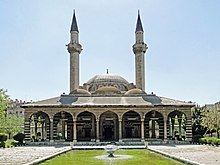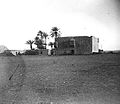Tekkiye Mosque
| Tekkiye Mosque التَّكِيَّة السُّلَيْمَانِيَّة | |
|---|---|
 Tekkiye Mosque | |
| Religion | |
| Affiliation | Islam |
| Region | Levant |
| Status | Active |
| Location | |
| Location | Damascus, Syria |
| Geographic coordinates | 33°30′45″N 36°17′29″E / 33.51250°N 36.29139°ECoordinates: 33°30′45″N 36°17′29″E / 33.51250°N 36.29139°E |
| Architecture | |
| Architect(s) | Mimar Sinan |
| Type | Mosque Complex |
| Style | Ottoman architecture |
| Completed | 1554–1558/59 (Mosque) 1566–67 (Al-Salimiyah Madrasa) |
| Specifications | |
| Minaret(s) | 2 |
| Materials | Stone, marble, mosaic |
The Tekkiye Mosque or Sultan Selim Mosque (Arabic: التَّكِيَّة السُّلَيْمَانِيَّة, romanized: et-Tekiyye es-Süleymāniyye, Turkish: Selimiye Camii or Sultan Selim Camii) is a mosque complex in Damascus, Syria, located on the banks of the Barada River.[1]
Construction[]
Sultan Suleiman I who had recently lost two sons, as he executed his son Şehzade Mustafa, followed by Şehzade Cihangir who died of grief, wanted to establish a mosque for the salvation of his soul, so he chose the site of his father Selim I's former palace in Damascus. The construction was commissioned in 1554–55 during the reign of governor Şemsi Pasha, until it was completed in 1558–59.[2]
The complex which is known as Tekkiye was masterminded by Mimar Sinan and built by local craftsmen,[3] on the location of Baibars' Ablaq Palace which was destroyed by Tamerlane forces during the siege of Damascus.[4]
The Sultan of the Ottoman Empire, Selim II, built the Sultan Selim Mosque in the then-suburb of Damascus by expanding his father's (Suleiman I) urban complex.[5] In addition, the construction of a madrasa began until 1566–67, to be known as Al-Salimiyah Madrasa, and was subject to the Hanafi school.[6]
The complex is composed of a large mosque on the southwest side of a courtyard, flanked by a single line of stone arcading, and a soup kitchen across the courtyard to the northwest, flanked by hospice buildings.[7] The mosque has two minarets and walls with alternating light and dark stripes. It has been described as "The finest example of Ottoman architecture in Damascus".[7][8]
The complex later served as a gathering point for pilgrims who wanted to prepare for the annual Hajj.[4]
Cemetery[]
The cemetery next to the mosque is the burial place of the last Ottoman Sultan Mehmed VI, who was dethroned and forced into exile when the Ottoman sultanate was abolished in 1922. He died on May 16, 1926, in Sanremo, Italy and was buried at the cemetery of the Sultan Selim Mosque. The mosque was chosen because it was located in the closest Muslim-majority country to Turkey and was built by his ancestors. There are almost thirty other graves of the Ottoman dynasty who died in exile and were not allowed to be buried in the Republic of Turkey at the time.[9]
Gallery[]

The minarets of the mosque seen from outside the fence

Tekkiye mosque in 1870

Courtyard of Tekkiye as-Süleimaniyye

Tomb of the last Sultan Mehmed VI
References[]
- ^ "Takiyya Sulaymaniyya, Damascus, Syria". Archnet Digital Library. Retrieved 20 March 2017..
- ^ Necipoğlu 2005, pp. 222–230.
- ^ Necipoğlu 2005, p. 224.
- ^ a b Darke 2010, p. 116.
- ^ "SULTAN II. SELİM'İN BANİLİK FAALİYETLERİ" [Construction activities of Sultan Seli̇m II] (PDF) (in Turkish). 2014. p. 755.
- ^ Necipoğlu 2005, p. 225.
- ^ a b Tekkiye Mosque Complex Archived 2007-10-07 at the Wayback Machine
- ^ Dumper, Stanley & Abu-Lughod 2007, p. 126.
- ^ Murat Bardakçı (6 March 2015). "Şam'daki mezar". Haber Turk (in Turkish).
Sources[]
- Darke, Diana (2010). Syria. Bradt Travel Guides. ISBN 9781841623146.
- Dumper, Michael; Stanley, Bruce E.; Abu-Lughod, Janet L. (2007). Cities of the Middle East and North Africa: A Historical Encyclopedia. ABC-CLIO. ISBN 9781576079195.
- Necipoğlu, Gülru (2005). The Age of Sinan: Architectural Culture in the Ottoman Empire. London: Reaction Books. ISBN 1-86189-244-6.
External links[]
| Wikimedia Commons has media related to Takiyya as-Süleimaniyya Mosque. |
- Takiyya al-Sulaymaniyya, Archnet
- Mosques completed in 1559
- 16th-century mosques
- Ottoman mosques in Syria
- Ottoman architecture in Damascus
- Mosques in Damascus
- Mimar Sinan buildings









